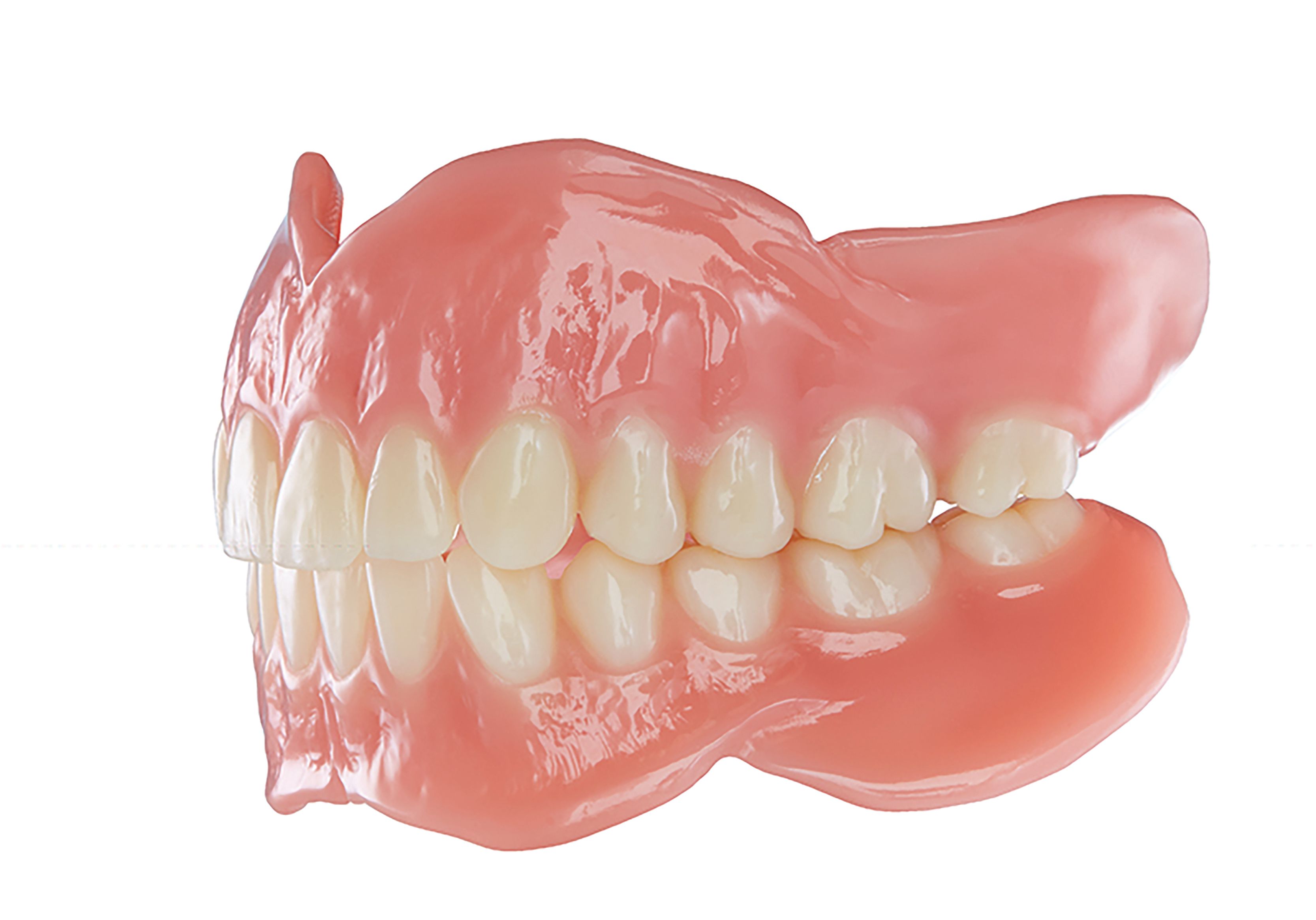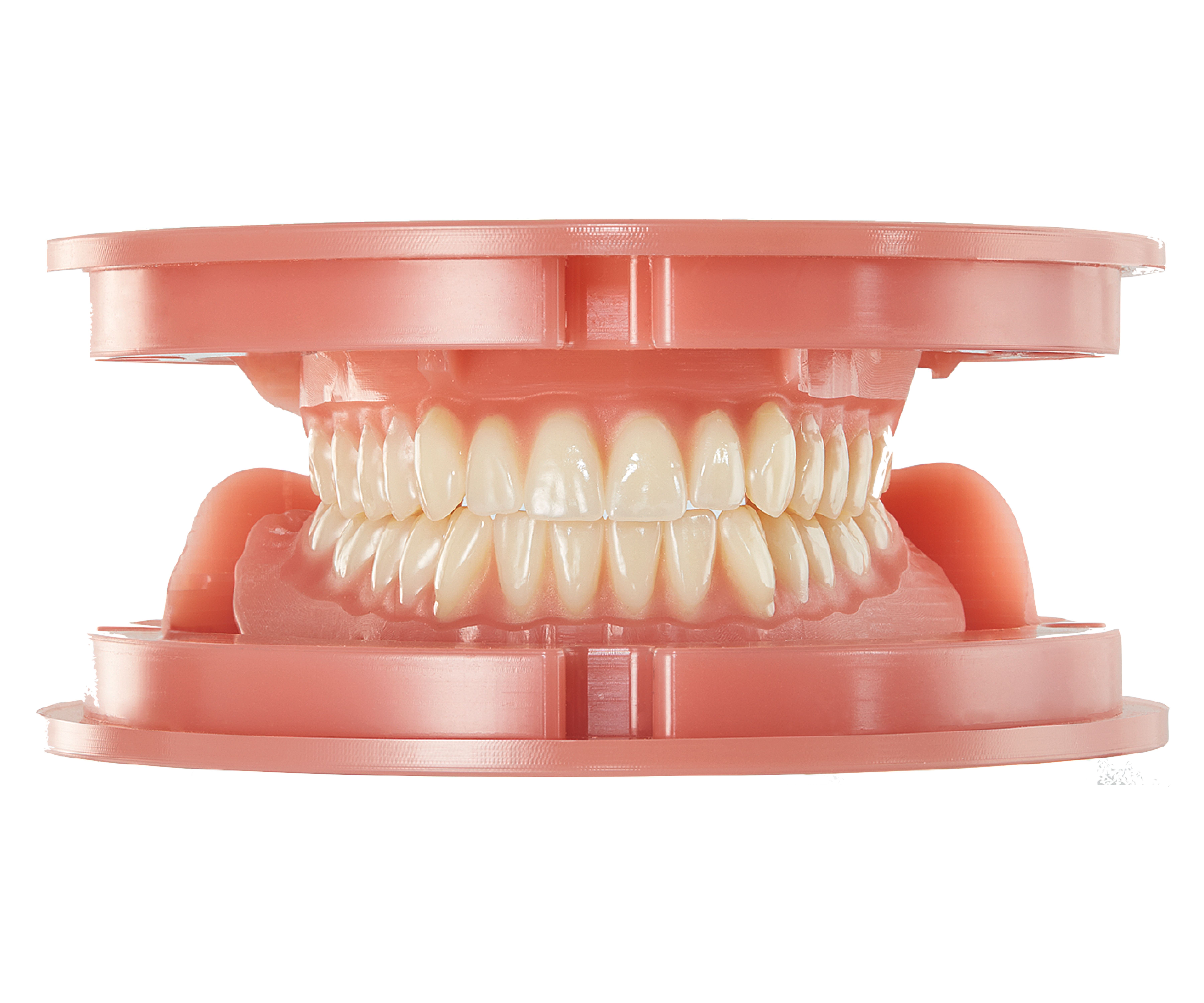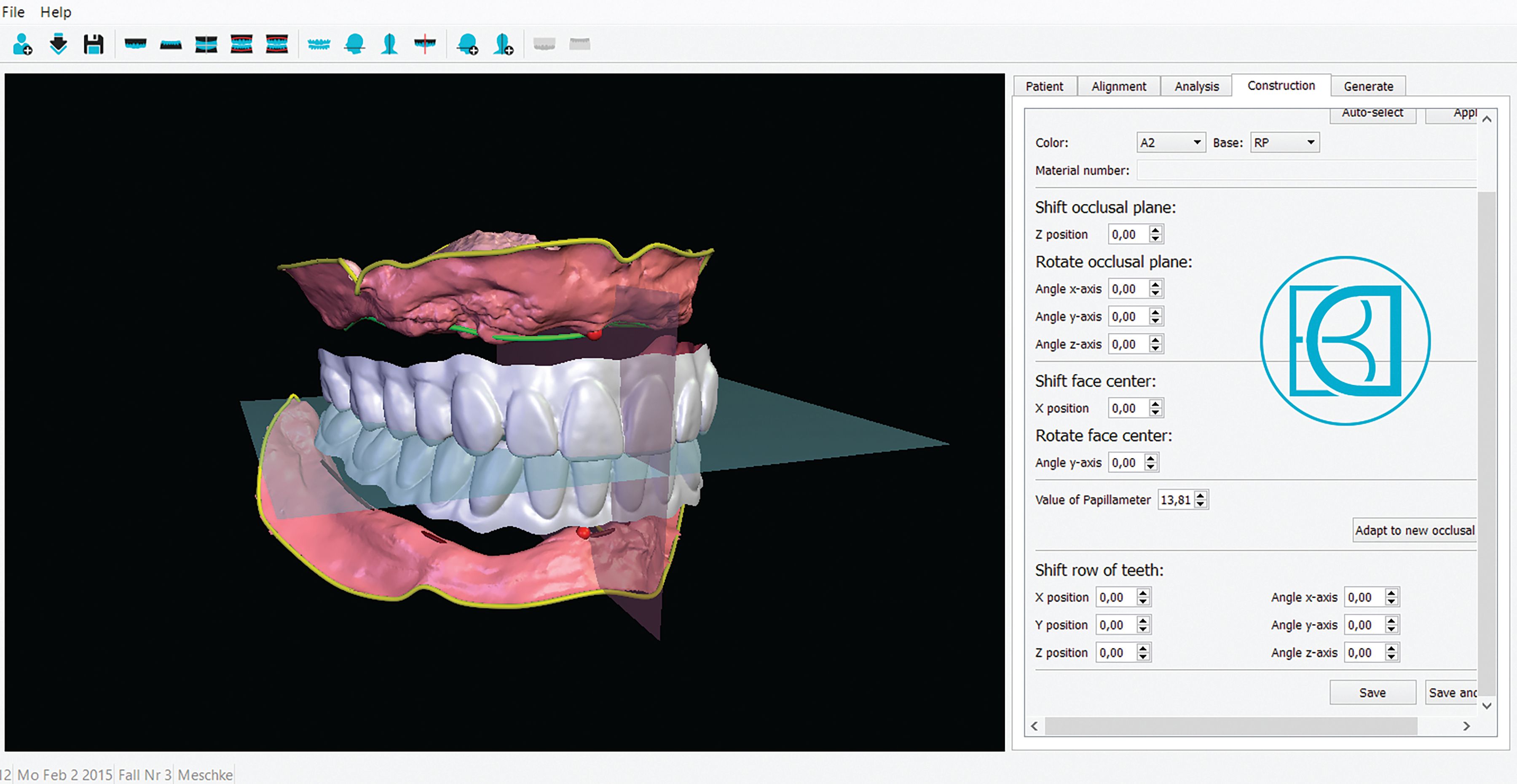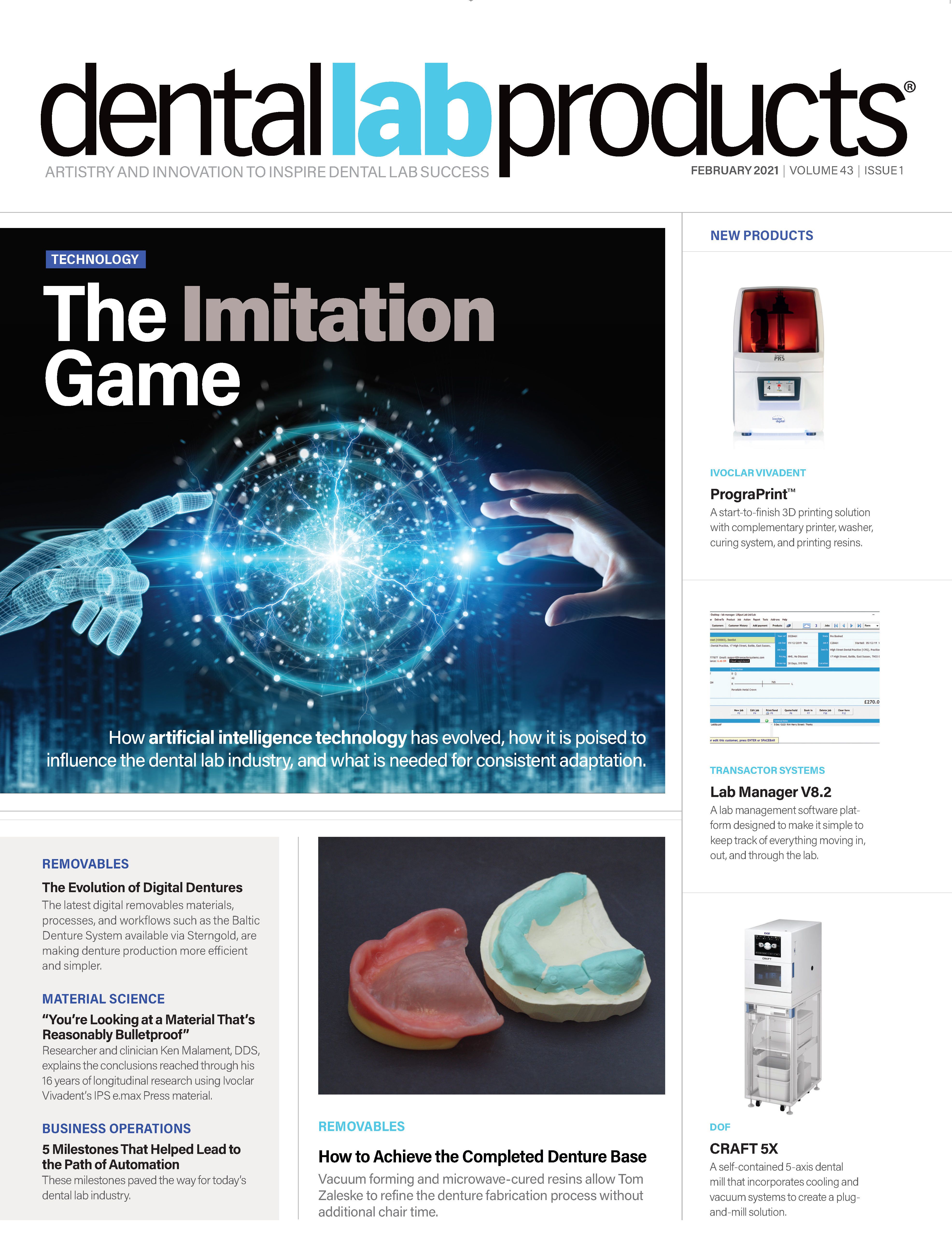The Evolution of Digital Dentures
The latest digital removables materials, processes, and workflows such as the Baltic Denture System available via Sterngold are making denture production more efficient and simpler.
A set of dentures completed using the Baltic Denture System.

The digital dental revolution has already firmly cemented its place at the center of fixed restoration production, but the adoption of digital denture workflows and products has progressed at a slower pace.
Fixed and removable production can reap benefits from digital technologies and the materials they process. Still, the shift to digital production of removable dental appliances is happening at a more measured pace.
This pace is due to many factors, but a big one is the learning curve and the full scope of actually creating a denture or other removable appliance. A single crown is fairly straightforward but shifting from designing it in wax to designing it on a computer screen is a leap, yet not always a gigantic one. However, removable appliance cases may involve multiple teeth and gingival tissues, and doing this digitally involves a bigger analog to digital transition, but that transition is well underway, according to Gene Peterson, CDT, director of Technical Development and Learning for Sterngold Dental.
“Through the last 9 years, there’s been a lot of advancements. Some people have said it’s been a revolution. Some people say it’s still evolving. I think it’s kind of both. I think it’s a revolution that’s evolving,” he says.
Today digital dentures are a reliable and viable option for many situations, Peterson says. The latest materials and systems can produce appliances that provide great fit, function, and esthetics to meet the needs of patients. These digital denture solutions offer far greater production efficiency and can drastically reduce the number of dentist appointments for the patient. Still, the move toward digital denture production remains a slow shift for the industry.
Peterson says removables technicians looking to shift to digital workflows often struggle to translate their skills and experience from the benchtop to the desktop. Although the essential steps of creating a denture remain the same, transitioning from the tactile analog process to the virtual digital process is the biggest hurdle for many clinicians.
“The idea is to find that harmony where you can bridge that gap easily and see the symbiosis between the 2, so they come together,” Peterson says. “You have to be able to say, ‘OK, this is what I did in the old world, and this is what I do in the new world, and now I do it with a mouse instead of a handpiece, and I’m good to go.’”
Peterson admits that digital dentures may not be the best match for every lab, every technician, and every practice. It’s a technology that should be embraced, and the technician should start thinking digitally. It’s been an excellent tool for the technicians, labs, and dentists who are truly engaging with the technology.
Digital Dentures Today
A variety of digital denture systems and materials are currently available. Some systems feature milled or 3D-printed denture bases with the denture teeth placed and bonded using longstanding analog techniques. Other systems offer a monolithic denture by milling the appliance from a special material composed of both gingiva and teeth.
Peterson noted that some systems require a large upfront investment in equipment and materials from the dental lab, whereas others can be leveraged with a minimal initial investment. Early printed denture bases have been criticized for lacking in characterization, but digitally produced dentures can all be customized to provide whatever level of esthetics are designed for that case.
Although the workflow used to get to the finish line is vastly different between analog and digital denture workflows (and even among the workflows of other digital denture systems), as with any case, success with digital dentures depends on having good information about the case at the start.
Peterson says creating a perfect digital denture requires accurate clinical information, including detailed impressions, an accurate bite, the midline incisal edge, proper lip support, the plane of occlusion, the tooth size, and the central height. As long as those measurements are accurate, digital denture design applications should provide a guided process to fabricate a digital denture that will be a perfect fit for the patient.
The highly accurate information captured in a digital impression is a great starting point, but the clinician should provide accurate measurements for all the details of the denture to turn a denture case into something akin to a crown appointment when the patient comes in once for prep, scanning, and design, and then returns for seating the final restoration. With accurate starting measurements, Peterson believes digital dentures can be the best and most efficient option for many patients, and clinicians can be sure of their measurements when they measure at least twice to make sure their numbers are repeatable.
“When they’re accurate, it’s going to go right in the mouth,” he says. “You’re going to have that 2-appointment denture, and that’s a key to digital dentures.”
Optimal Efficiency With Workflow Flexibility
The BDLoad pucks feature preset teeth in centric occlusion.

Sterngold recently partnered with Merz Dental which provides the Baltic Denture System (BDS), a versatile digital denture solution that standardizes parts of the design and fabrication to make the production process as simple and efficient as possible. The solution includes BDCreator® PLUS, a customized software application that guides technicians through the design steps. The designs are then milled from special BDLoad® discs, which come preformed with denture teeth set up in an optimized lingualized occlusion. This allows the system to go directly from design, to milling, to finishing without the need for multiple try-ins or a lengthy setup process.
“It’s a milled premium denture,” Peterson says. “It’s a monolithic final denture that looks beautiful.
“For a premium denture, you’re getting a lot for your buck,” he continues. “In fact, in its simplicity, it will exceed your expectations because what you’re getting and what you’re able to do with this software and the final product is something that nobody else is really doing at this price point.”
Peterson has experience working with multiple digital denture solutions and working for companies behind the scenes. He likes the BDS because it offers both simplicity and versatility. The solution can be used for denture sets or single arches and can even be used for immediate dentures. Because it offers clinics the benefit of faster-finished dentures at a lower cost, labs can jump into the solution in multiple ways.
Labs with a compatible mill are ready to do everything on-site and can invest in the full solution to create their digital dentures completely in-house. Those without a mill or looking to start smaller can design in-house and send files to Sterngold for milling. Alternately, labs can take on any of the steps in-house and outsource the rest of the process. In the end, all the paths lead to digital dentures being delivered to the prescribing clinic.
On the materials side, the BDLoad pucks are manufactured from highly esthetic, high-impact PMMA, which can be characterized and finished like any standard denture. The preset teeth are affixed using a process that creates a true chemical interface between acrylic used for the gingiva and the material used for the teeth. This process creates a monolithic denture with distinct teeth and gingiva, and virtually eliminates the risk of teeth debonding and needing replacement.
“You’re not going to have pop-outs,” says Peterson. “You’re not going to have fracture failures because there’s no mechanical bond to break.”
Denture Command Center
BDCreator PLUS is used to design a set of dentures.

Like any digital solution, the software is a key part of the digital denture process, and this is the area where things have truly advanced in recent years, according to Peterson. The major dental CAD/CAM applications from companies such as exocad and 3Shape now offer removables modules that technicians can use with multiple digital denture materials and workflows, but some systems, such as BDS, offer their own software platforms tailored to the specific approach to digital dentures. Peterson describes the BDCreator PLUS application as intuitive and automated with a step-by-step approach that walks the technician through each part of the process.
“The software journey has been what’s really made the difference,” Peterson says.
Although digital denture software might be easier to use, it still requires specialized knowledge and training for the digital technician to follow the software prompts and recognize what is accurate and what needs to be adjusted. Like any system, the quality of the output is directly related to the quality of the input, so even though the system can make suggestions and automate steps, the technician using the controls still needs to know enough to recognize when the computer is heading off course.
The Future of Digital Dentures
The way Peterson sees things, digital dentures are fully ready for primetime today, and the only things holding them back are trust in the process from the clinicians and buy-in and training from the technicians. He adds that solving the first challenge is going to be easier than the second.
Getting clinicians on board with digital dentures should be achievable. When done correctly, the quality of digital dentures can meet the demands of most dental practices. Convincing dentists to commit to milled digital dentures rather than printed dentures, for the time being, is part of achieving this goal. Although Peterson says printing will be the industry standard when printers and materials improve enough to surpass the quality of milled dentures, he thinks milled restorations are the best option today.
With quality no longer a barrier, clinicians really only need to be convinced that they can get equal quality dentures in far less time by embracing a digital process. In fact, Peterson believes digital dentures could be just the thing to get clinicians excited about providing dentures for their patients.
“It’s my passion to get doctors to the point where they’re comfortable and consistent making the records, and they enjoy making dentures again,” Peterson says. “If you can get some basic consistency down in your record making, you’re going to have a lot of enjoyment out of making dentures, and it can be a hugely profitable aspect of your business.”
Unfortunately, increasing the number of digital denture technicians will be a bigger challenge. Peterson says the barriers on the lab side are more challenging because they are institutional. There is a declining number of schools and educational opportunities for new technicians, and many established removables technicians are not interested in learning a new approach to their craft.
According to Peterson, a key to breaking down this barrier is setting technicians up for success when they start learning the digital denture processes. They need to not only understand the software workflows but also how to identify when inaccurate data are causing problems with the denture design. Digital denture technicians need to be ready to coach the doctors and drive home how accurate information at the start leads to efficient production and dentures that fit right the first time. With an automated digital workflow, the problems that might arise will rarely originate at the lab.
“With digital dentures, they can’t blame a technician anymore because [they are] just putting in information that they give [them],” Peterson adds, once again noting the importance of accurate scans and measurements from the dentist.
Labs often face a barrier to entry into new digital platforms due to the cost. Peterson says this led to innovations like BDS where a lab can embrace it 1 piece at a time and build up enough business to generate a quick return on investment by automating production step.
When it comes to the need for more digital denture technicians, Peterson says it may take time. He does not expect the established generation of denture technicians to shift to digital in large numbers. They’re largely comfortable with the way they work and don’t have immense pressure forcing them to make a switch.
However, the next generation of lab technicians will be trained in a digital environment and might learn digital techniques before or in lieu of analog workflows. Even though they will enter a much more automated industry than previous generations, they will still need to learn the same key details about the engineering, chemistry, and design of dental restorations, whether they work at a bench or a keyboard.
Peterson says he’s excited about how far digital dentures have come and looks forward to being a part of the continued development of the removables side of digital dentistry. The tools and materials required to make dentures will evolve, but the core knowledge at the heart of designing a removable dental restoration will remain the same.
“I’ve been in this for 10 years, and when I first got into doing this, people would say, ‘You’re going to make my grandma’s dentures with a computer? Are you kidding me?’” Peterson says. “The format is different, but the details remain the same. Technicians, per se, aren’t going to go away. They’re just going to be doing different things.”
